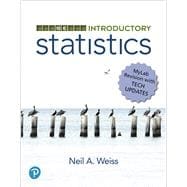NOTE: Before purchasing, check with your instructor to ensure you select the correct ISBN. Several versions of the MyLab™ and Mastering™ platforms exist for each title, and registrations are not transferable. To register for and use MyLab or Mastering, you may also need a Course ID, which your instructor will provide.
Used books, rentals, and purchases made outside of Pearson
If purchasing or renting from companies other than Pearson, the access codes for the MyLab platform may not be included, may be incorrect, or may be previously redeemed. Check with the seller before completing your purchase.
For one- or two-semester courses in Introductory Statistics.
This package includes MyLab Statistics.
Statistically significant
Introductory Statistics MyLab Revision, 10th Edition is ideal for introductory statistics classes that emphasize statistical reasoning and critical thinking. Weiss’s meticulous and comprehensive coverage includes careful, detailed explanations to ease the learning process. With more than 1,000 data sets and over 3,000 exercises, this text takes a data-driven approach that encourages students to apply their knowledge and develop statistical understanding.
Weiss offers a parallel presentation of critical-value and P-value approaches to hypothesis testing. This unique design allows the flexibility to concentrate on one approach or the opportunity for greater depth in comparing the two.
Personalize learning with MyLab Statistics
By combining trusted author content with digital tools and a flexible platform, MyLab Statistics personalizes the learning experience and improves results for each student. With MyLab Statistics and StatCrunch®, an integrated web-based statistical software program, students learn the skills they need to interact with data in the real world.
0135230004 / 9780135230008 Introductory Statistics MyLab Revision Plus MyLab Statistics with Pearson eText - Access Card Package
Package consists of:
- 0135163056 / 9780135163054 Introductory Statistics, MyLab Revision
- 0135190177 / 9780135190173 MyLab Statistics with Pearson eText - Standalone Access Card - for Introductory Statistics, MyLab Revision











